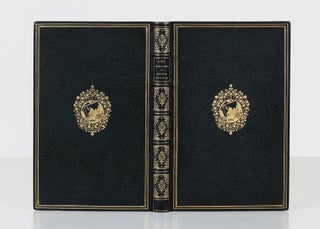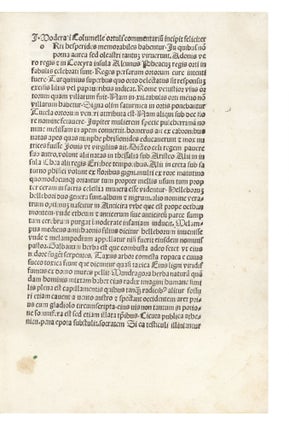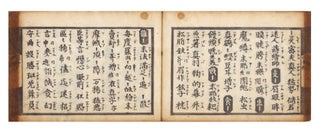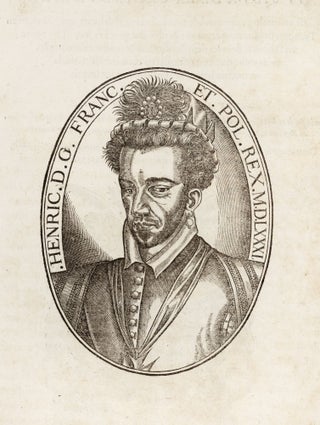![Item ID: 8673 Eight orihon (accordion format), finely woodblock-printed, of the complete Lotus Sutra [S.: Saddharmapundarikasutra; J.: Myohorengekyo 妙法蓮華経 ]. LOTUS SUTRA.](https://jonathanahill.cdn.bibliopolis.com/pictures/8673.jpg?width=768&height=1000&fit=bounds&auto=webp&v=1673468799)
A Rare Small-Format Kasuga-Ban
Eight orihon (accordion format), finely woodblock-printed, of the complete Lotus Sutra [S.: Saddharmapundarikasutra; J.: Myohorengekyo 妙法蓮華経 ].
17 characters per column; 5 columns per page. Text-block height: 126 mm. Each column ruled in gold, with gold borders on top & bottom. Eight vols. (172 x 6285; 7260; 6830; 5980; 6530; 6280; 5860; 5125 mm.). Narrow 8vo, orig. semi-stiff blue boards (some rubbing), decorated on the outside with patterns in gold & silver of flowers, heightened with sprays of gold (kindei; “golden mud”); inner endpapers decorated with gold & silver speckles. Title and volume number in manuscript on each upper cover. [Japan, probably at Nara]: Kasuga-ban, mid- to late Kamakura (ca. 1250-1333).
A luxuriously produced and most unusual small-format kasuga-ban edition of the complete Lotus Sutra in 28 chapters, originally translated into Chinese by Kumarajiva and completed in 406. Our copy of this edition is a luxury version, with each column of text ruled in gold pigment. We have never seen a small-format kasuga-ban before.
The Lotus Sutra is the most influential of all sutra and “was highly influential in East Asia, inspiring both a range of devotional practices as well as the creation of new Buddhist schools that had no Indian analogues.”–Buswell & Lopez, eds., The Princeton Dictionary of Buddhism, p. 730. For several Japanese schools of Buddhism, the Lotus Sutra remains their central text and is considered to be the only valid Buddhist sutra for the Degenerate Age.
These handsome scrolls have been printed on high-quality pale brown-gray paper (gampi, or mulberry fibers), and printed in bold, thick strokes, using lacquer-like black sumi ink, typical of Kamakura and Muromachi kasuga-ban printings (kasuga-ban is a general term for publications of the Nara monasteries; see below).
Kumarajiva (344-413), Buddhist monk, scholar, missionary, and translator, who came from the Silk Road kingdom of Kucha, was famous for his encyclopedic knowledge of Indian and Vendantic learning. He was the greatest translator of Buddhist scripture from Sanskrit into Chinese, and it was largely owing to his efforts and influence that Buddhist religious and philosophical ideas were disseminated in China. Following many years of study in Kucha and Kashmir, he arrived in Chang’an (now Xi’an), in 401. with a great reputation. He became known as “teacher of the nation.” There, he headed a famous school of translators, and together they translated many important texts into Chinese, including the Vimalakirti, the Diamond, the Lotus, and the Amitabha sutra.
It is most unusual to find an early printing of a long sutra, like the Lotus Sutra, textually complete; usually one finds just one part of a text in one scroll. Complete sets of this work are of the greatest rarity.
PROVENANCE: our set has been signed twice by the Buddhist scholar and priest Dohan [Kakuhonbo] (1179-1252), a “Kamakura-period Shingon scholar-monk from Koyasan, who wrote extensively on the works of Kukai and Kakuban. He is well-known for his esoteric writings on the Pure Land.”–Buswell & Lopez, eds., op. cit., pp. 263-64.
A fine and remarkable set, preserved in an attractive old wooden box. There is some relatively minor worming, touching some characters.
❧ K.B. Gardner, “Centres of Printing in Medieval Japan: late Heian to early Edo period” in British Library Occasional Papers 11. Japanese Studies (ed. by Yu-Ying Brown), London: 1990, p. 159–”The term Kasuga-ban became used more loosely, in a wider sense, to denote publications of the Nara monasteries in general, not only of the Kofukuji. The printing of Kasuga-ban in this broader sense flourished throughout the Kamakura period and up to the end of Muromachi (ca. 1570).”.
Price: $75,000.00
Item ID: 8673




